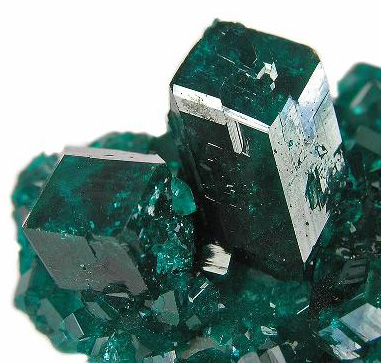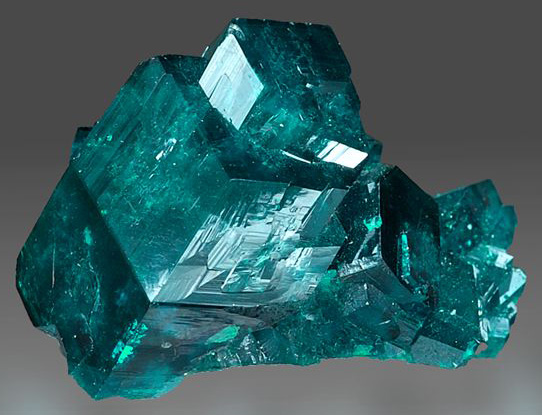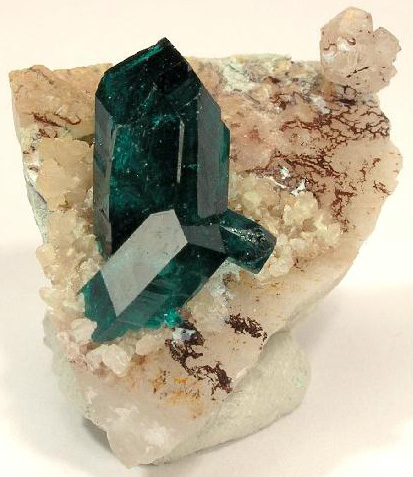Dioptase
Dioptase is an emerald green to blue-green copper silicate mineral with the chemical formula CuSiO3·H2O. It was named by mineralogist R.J. Hauy in 1797 from a find in Kyrgyzstan (a country in central Asia) and takes its name from Greek words for "to see through", in reference to its two internal planes of cleavage, which are visible in undamaged crystals. [1] [2]

Dioptase
From the Tsumeb mine, Namibia. Overall size 9.5 x 5.5 x 3.5 cm.
Photo by Rob Lavinsky, iRocks.com - lic. under CC-BY-SA-3.0
Dioptase is notoriously fragile and so not best suited to use in jewelry settings, but has on occasion been fashioned into gemstones. These are typically small - less than 1 carat and may be seen priced around $100 per carat - and are more the preserve of aficionados and collectors of rare minerals and precious stones.
Dioptase has a hardness of 5 and can form striking crystals, as can be seen in the images. It crystallizes in the trigonal crystal system (six sided columns) with rhomboheral terminations. It can also occur in the form of druse - a "carpet" of tiny crystals.
Dioptase is mostly found in desert regions, where it is formed by a complex process from copper sulphide. [2]
The finest examples of dioptase were found in Namibia in the famous Tsumeb mine, however this source of dioptase is said by reputable sources to be exhausted. Other locations in Namibia seem to be producing dioptase, including the Okandawasi Mine in Kaokoland, a wilderness region in the north of the country. Other specimens currently being sold are stated to originate in the Democratic Republic of Congo, namely the Kipemse Tatara Mine, Katanga, Congo. Further locations from which dioptase has been reported include the Altyn Tube mine in Kazakhstan [2] , Argentina, Australia, New Zealand and the deserts of the southwestern USA, including the Christmas and Harquahala Mines, Arizona USA.
Dioptase is sometimes found in association with other copper minerals such as azurite, chrysocolla, bornite and malachite. It is also often found with quartz, wulfenite, mimetite, hemimorphite, dolomite, limonite, cerussite or fluorite. [1]
Dioptase Other Names
Dioptase has also acquired a number of other names over the years, including achirite, achrite, dioptasite, emerald-copper, emerald-malachite, kirghisite. [1] It has also been nicknamed "the gem of the Congo". [3] It should of course be noted that dioptase is not related to emerald except through its color, and doesn't contain emerald - although it has on occasion been confused with it owing to its often "deep green" color.

Dioptase
From the Tsumeb mine, Namibia. Overall size 3.5 x 2.5 x 2 cm.
Photo by Rob Lavinsky, iRocks.com - lic. under CC-BY-SA-3.0

Dioptase
From the Kunene Region, Namibia. Overall size 2.5 x 2.5 x 2.3 cm.
Photo by Rob Lavinsky, iRocks.com - lic. under CC-BY-SA-3.0

Dioptase
From the Tsumeb mine, Namibia. Overall size 4.75 x 3 x 2 cm.
Photo by Rob Lavinsky, iRocks.com - lic. under CC-BY-SA-3.0
Dioptase - Sources Referenced:
[1] http://www.mindat.org/min-1295.html
[2] http://en.wikipedia.org/wiki/Dioptase
[3] http://www.jewelsforme.com/Dioptase.asp?gemtype=GS
Back to the Gemstones List home page - over 160 gemstones explored!
Please feel free to link to this page - copy / paste the text below: (click to select)
Privacy Policy | Cookie Policy | GDPR | About This Site / Terms

© gemstoneslist.com


